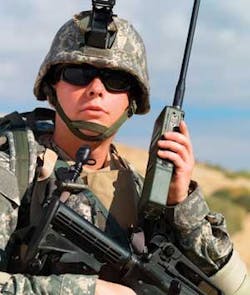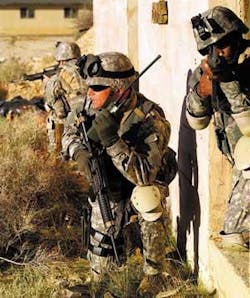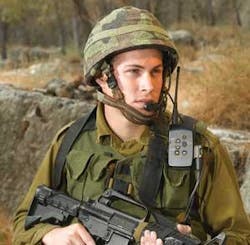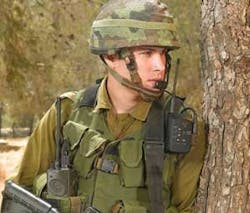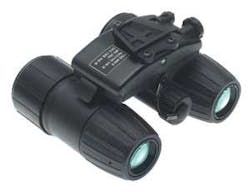Commandos in the field, who scorn traditional military standards, are setting the bar high for night-vision devices, handheld radios, and batteries that must perform in far more demanding conditions than conventional military gear.
By Ben Ames
All fighting forces demand rugged electronics, but when it comes to abusing their equipment, special operations forces set a new standard.
They take the classic demand for lower size, weight, and power (SWAP), and find creative solutions-like cutting the facemask off a night-vision goggle assembly to shave weight.
The nation’s Green Berets, Rangers, SEALs, and other commandos also present a challenge for contractors because special operations forces scorn typical military standards. It is tough to mount a headset on a helmet when these guys use a wide variety of styles instead of predictable gear.
They change more than just headgear; instead of traveling in just one vehicle, special operations forces can leap from small boats to speedy dune buggies to helicopters within a mission. Since they operate in small, clandestine units, they cannot rely on supply depots for spare parts. The equipment had better work right the first time, or be simple enough to repair in the field.
Future versions of night-vision scopes will use enhanced-night-vision-goggle (ENVG) technology that shows image intensification (green) and infrared (orange).
“In the special ops community they like to get out of boats underwater. Guys get out of subs with a sack full of goodies at pressure and depth,” says Larry Curfiss, vice president and director of business development for ITT Night Vision in Roanoke, Va.
ITT engineers had to meet this challenge when they created a night-vision goggle for driving. Some troops had been using the Generation 2 AN/AVS-5 series-designed for flying-and cut away the facemask, he says. Special operations soldiers also had the Generation 3 PVS-7 model, which used just one tube but offered no depth perception.
“When you drive a car, you tend to want to know where both of your fenders are. So you need stereoscopic vision,” Curfiss says. “If you’re driving a humvee or a special operations sand dune buggy, you get jarred around a lot, so goggles were breaking. They needed more rugged ones.”
First, ITT offered the F5050, a two-tubed, bulked-up aviation goggle, which was popular but still too heavy. Now the company has created the F2525 Miniature Individual Night Imager-Binocular (MINI-B), due for release in mid-2006.
The MINI-B offers the same high-quality Generation 3 night-vision capabilities of the AN/PVS-23 (F5050) binocular night-vision goggle, but in a smaller, lighter package capable of being submerged to 20 meters, the company says. The reduced size and weight allow easier individual movement and covert operations. Designed for maximum durability, the unit also offers flexibility as either a handheld, head-mounted, or helmet-mounted unit.
The special operations community prefers the shape of the PVS-14 monocular because it can be used on weapons, Curfiss says. The two-eyed MINI-B is also designed to allow users to take apart the tubes, attach a power unit, and use the remaining monocular as a weapon sight.
The AN/PRC-152 radio from Harris Corp. is a multiband, software-defined unit that is small enough for tactical operations.
A special challenge in designing the goggle for special operations was to make it helmet-mountable, he says. U.S. Army soldiers use one standard type of helmet. But special operations forces use many different styles, so ITT designers had to design a new kind of clip.
To save weight, the unit is adaptable to use 16-millimeter tubes. “Current versions use a pair of standard 18-millimeter tubes, but as the enhanced night-vision goggle (ENVG) comes further into production, costs come down, and we will migrate to 16 millimeter,” Curfiss says.
Special forces demand lighter radios
Most troops who are trained to fight on the digital battlefield are clamoring for larger displays so they can read more maps, satellite terminals so they can download videos filmed from unmanned aerial vehicles, and rugged computers so they can tap into battlefield networks like Force 21 Battle Command, Brigade and Below (FBCB2).
Special operations forces, however, are headed in the opposite direction. They still rely on advanced electronics to move with speed and stealth through hostile territory, but the last thing they want is one more gadget to hang on their vests.
“If there’s one trend now in the special operations marketplace, they want to do everything they can do now, but do it in a smaller device,” said Don Lockwood, business development manager for special operations forces for the Harris Corp. RF Communications Division in Rochester N.Y.
Engineers can help shrink that heavy load of batteries, cables, and devices in two ways-either by designing smaller radios, or by combining several devices into one. Many special forces today, in fact, will carry one radio for local communications, another to reach their distant headquarters, and a third device for situational awareness functions such as blue-force tracking.
That presents a challenge when the troops are under pressure. “The demands of special operations are greater than ever before. They are still doing the same type of action, but their op-tempo has increased greatly,” Lockwood says.
In response, designers at Harris are trying to fit those functions into future generations of the Falcon III AN/PRC-152 multiband handheld radio, which will be able to handle waveforms of the Joint Tactical Radio System (JTRS). They will achieve it with software, since the PRC-152 runs on the Pentagon’s software communications architecture (SCA) standard. Once the design is ready, they will port the new waveform to each unit.
The Tadiran PRC-710MB (in vest pocket) is a multiband handheld radio for voice and data.
Since Pentagon leaders are shifting the JTRS to lower priority, this type of radio takes on more importance. “As the JTRS program has been pushed to the right (delayed), the Department of Defense’s big push is to look for other technology to field right away,” he says.
The Harris Falcon II products include the PRC-150 and the AN/PRC-117F, called the 117 Foxtrot. The PRC-152 is the handheld member of Harris’ Falcon III generation of products, set for delivery in January (see “Harris supports communications,” p. 33).
Small units need short-range radios
Another software-based radio for special operations forces is the PNR-500 from Tadiran Communications in Holon, Israel. The Personal Net Radio (PNR) is a digital squad radio designed to operate in demanding environments from urban warfare to combat ships. It operates over frequencies from 400 to 450 MHz with 15 channels.
This UHF signal propagates well through diverse terrain, although it carries just a kilometer in range. That combination is tailor-made for small units of special forces whose primary need is to talk with each other in areas ranging from urban buildings to thick jungle.
The 13-ounce radio also allows conference calls involving three to six people, instead of the standard person-to-person walkie-talkie. And for tactical stealth, the radio has no display screen. “Our customers want a black box, so it doesn’t blink at night or use up extra batteries,” says Gil Meltzer, marketing director at Tadiran.
The radio manages these demands with its software architecture. Using time-division multiple access (TDMA) to divide a radio signal into several channels, it can handle voice and data, and can create virtual private channels so many small groups can communicate without using all the bandwidth.
Special Operations forces asked for a lightweight, two-eyed binocular for driving at night, so ITT created the MINI-B.
One button-push connects them all again, and their commander can connect to a stronger radio if he needs to use VHF or other bands to talk with headquarters 10 or 15 kilometers away. Pentagon designers are considering the PNR-500 for the Land Warrior program, Meltzer says.
For a more integrated solution, Tadiran combines the PNR-500 with other “building blocks.” They use the RPDA-55 rugged personal digital assistant-a GPS-enabled computer based on the Hewlett-Packard iPaq-for navigation and blue-force tracking, for example, and the VIC-500 wireless intercom to enable soldiers to communicate as far away as 800 meters from their vehicles.
Pentagon leaders chose the RPDA for CHS III-stage three of the combined hardware and software program. The RPDA 55’s cousin, the RPDA-88, has 64 megabytes of SDRAM and 32 megabytes of flash memory, with an Intel StrongARM SA1110 processor running at 206 MHz.
Roadmap to lighter weight
Tadiran engineers are working on three objectives for future versions: improve lethality, shorten time to kill, and make the most of survivability, Meltzer says. Part of that equation is keeping the weight low so the combined radio and PDA weigh less than 2.2 pounds.
Another way to cut weight is to use wireless connections to connect all parts of the system except the external battery connection. “We’re also exploring Bluetooth wireless accessories,” he says.
Power is another challenge. “We’re working on an external power source, because now each has its own batteries,” Meltzer says. “A lithium ion or fuel cell would enable all the units to recharge from a central source.”
Ultimately, Tadiran designers want to offer a system to match every user’s needs. “The future is a complete wearable system. Since we have the building blocks, users could enjoy a tailor-made suit,” Meltzer says. “They could say ‘I like the technology but I would like to wear it differently,’ and put batteries on their back, break the radio into two small boxes, use an integrated wearable antenna, see a head-up display, break up the computer into a couple of pieces, or almost anything.”
Harris supports communications
The Harris Corp. RF Communications Division in Rochester, N.Y., announced three contracts in late 2005 to supply radios to the Army, Marine Corps, and Air Force. Each contract supports handheld and manpack units that support communications for special operations as well as traditional military units.
In September, leaders at the U.S. Army’s Communications-Electronics Command (CECOM) awarded a $37.8 million contract to Harris RF for more than 1,300 Falcon III dual AN/PRC-152 Multiband Handheld Radio and Vehicular Adapter Amplifier systems. Deliveries of the radios will wrap up by June 2006.
“The AN/PRC-152 vehicular radio systems will allow the U.S. Army to have the vehicular radio functionality and output power that they rely on for long-range communications, with the portability of a tactical handheld for quick-dismount scenarios,” says Dana Mehnert, vice president and general manager of U.S. Government Products at Harris.
The AN/PRC-152 can easily be upgraded to provide additional capabilities in the future utilizing the Software Communications Architecture (SCA) and the Harris Sierra II software programmable encryption module. The AN/PRC-152 is the first NSA-certified radio to implement the SCA.
To facilitate integration with the customer’s legacy systems, Harris designed the AN/PRC-152 radio systems to be compatible with the Army’s existing vehicular mounts and cables.
In its vehicular configuration, the AN/PRC-152 consists of a multiband handheld radio transceiver, a 50-watt, long-range power amplifier, and an integrated handheld battery charger. As delivered, the AN/PRC-152 provides interoperability with key waveforms, including SINCGARS, HAVE QUICK II, and VHF/UHF AM & FM. With the AN/PRC-152 mounted in the vehicular adapter amplifier, the system provides a 50-watt output in the VHF (30-90 MHz) band. Multiband operation is made simple with a separate antenna port for the 90-512 MHz band.
In October, the U.S. Marine Corps awarded Harris a contract for the service’s MBMMR (Multiband, Multimission Radio) Standardization Program with its Falcon II AN/PRC-117F radios.
The first delivery orders of $67 million have been awarded as part of a multiyear $205 million blanket purchase agreement. Deliveries of the new MBMMR systems will begin in the company’s second fiscal quarter.
The radios will be used to upgrade and replace the Marine Corps’ active duty and reserve components’ legacy tactical radio systems, and also will be used for other Marine Corps programs such as TLDHS (Target Location, Designation, and Hand-off System), CI/HUMINT (Counter Intelligence/Human Intelligence), and ABV (Assault Breacher Vehicle).
Under the contract, Harris will supply its AN/PRC-117F manpack and AN/VRC-103(V) vehicular systems. The Harris AN/PRC-117F is a software-defined, multiband radio covering the entire 30-to-512-MHz frequency spectrum. Its embedded COMSEC has NSA certification, ensuring compliance with secure U.S. Government Type-1 encryption algorithms. In addition, the radio is JITC certified for operation over military standard satellites.
The AN/VRC-103(V) vehicular product is a fully integrated, compact communications system that includes the Harris AN/PRC-117F tactical radio and the Harris AM-7588 Multiband Power Amplifier. This system also covers the entire 30-to-512-MHz frequency range, offering 50-watts PEP transmit power, embedded COMSEC, SATCOM, and ECCM capabilities.
In November, the U.S. Central Command Air Force (USCENTAF) ordered $4.8 million in Falcon III AN/PRC-152 multiband handheld and Falcon II AN/VRC-103 vehicular units utilizing Harris AN/PRC-117F manpack multiband radios for use in Iraq and Afghanistan.
“The similarity of operation between the AN/PRC-117F and AN/PRC-152 reduces training time and will allow the Air Force to quickly field the radios to support crucial rotational deployment schedules,” says Mark Moretto, major account manager at Harris RF.

